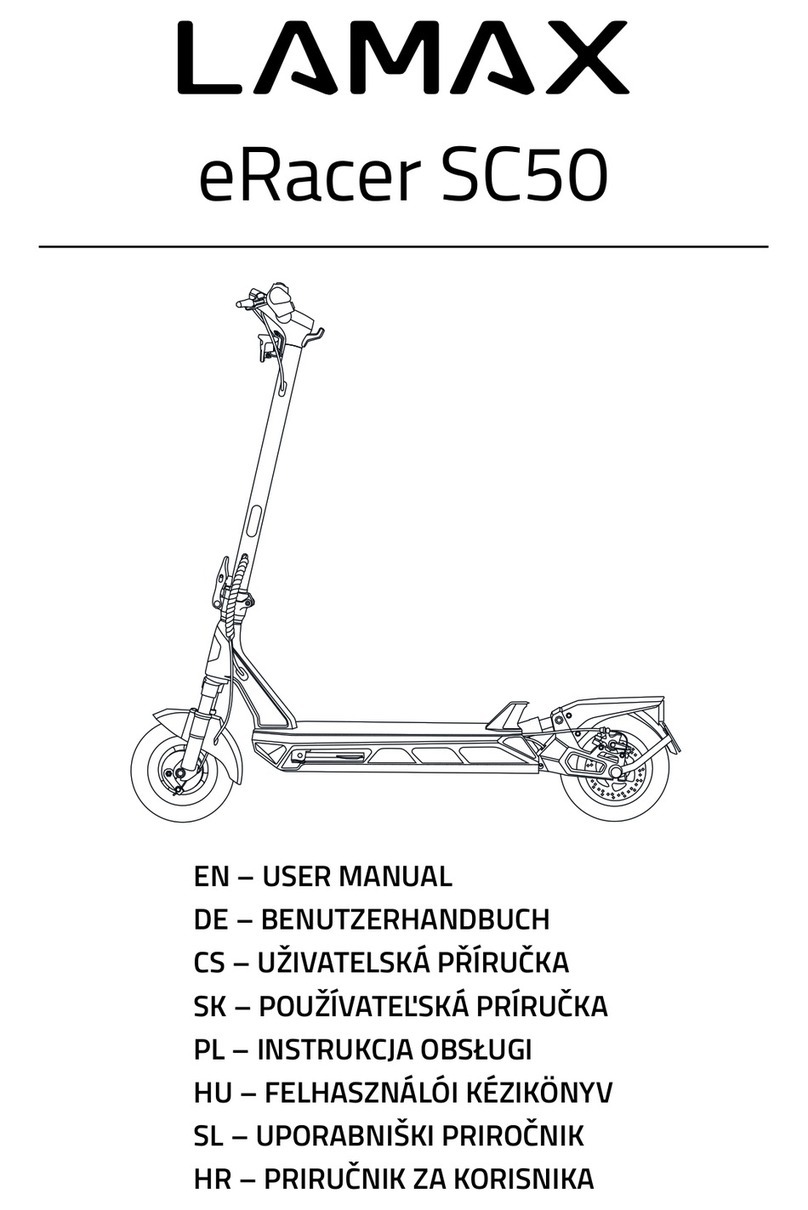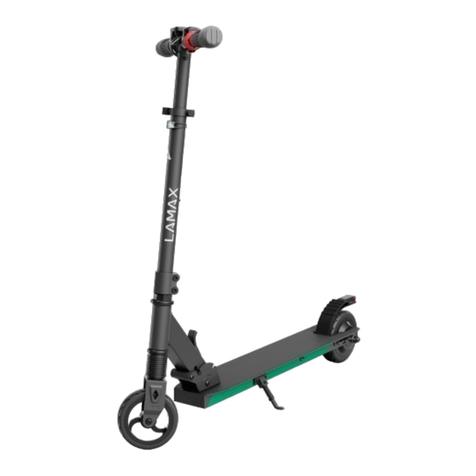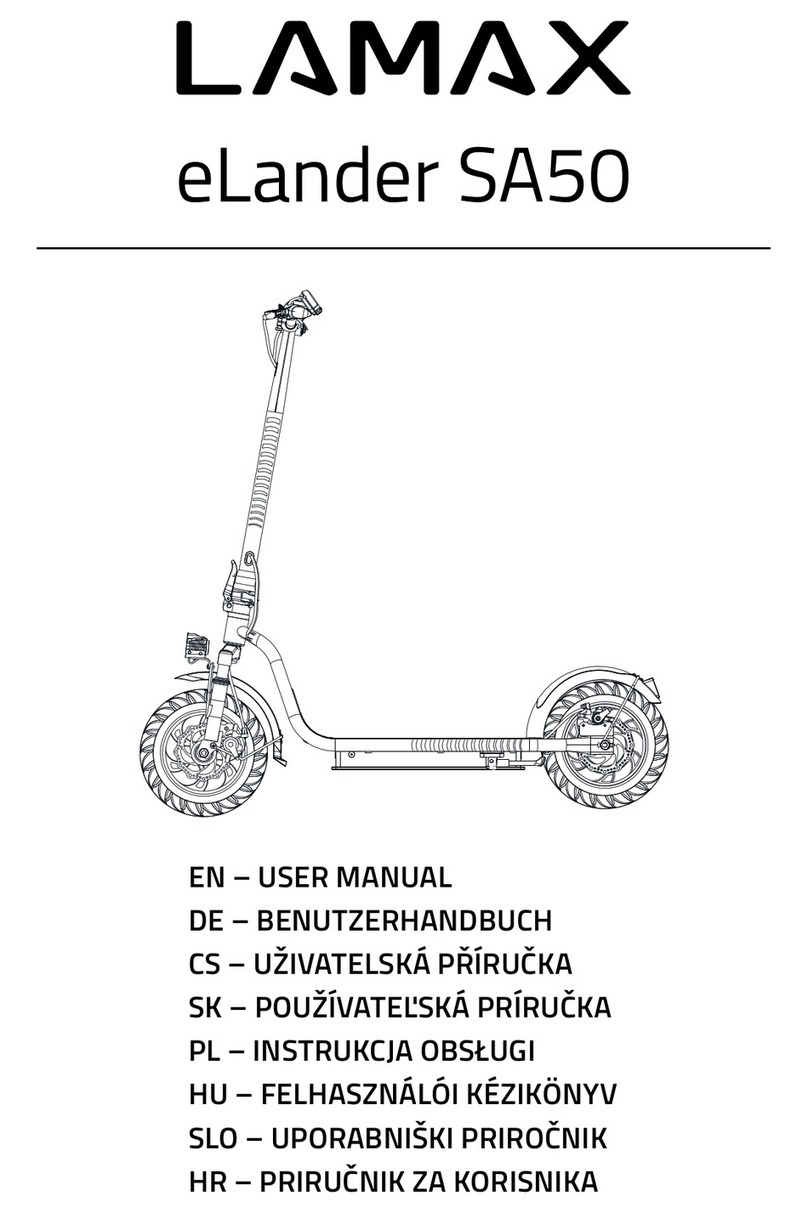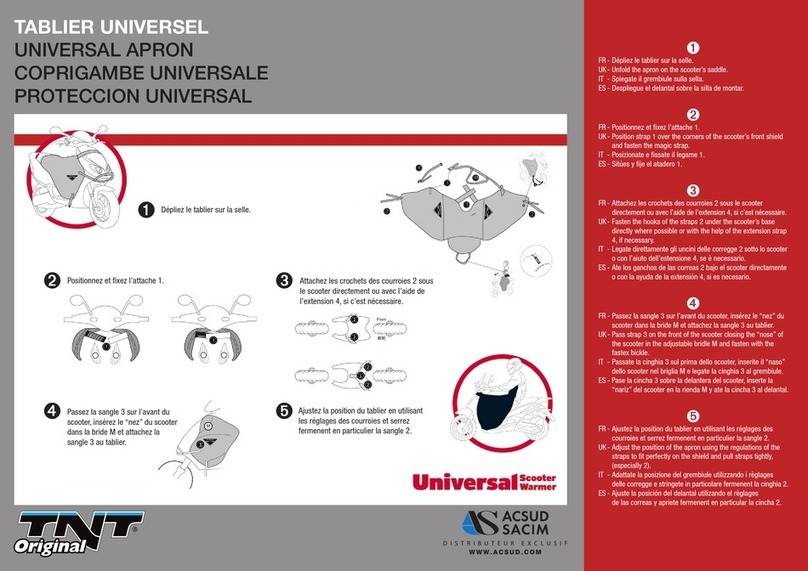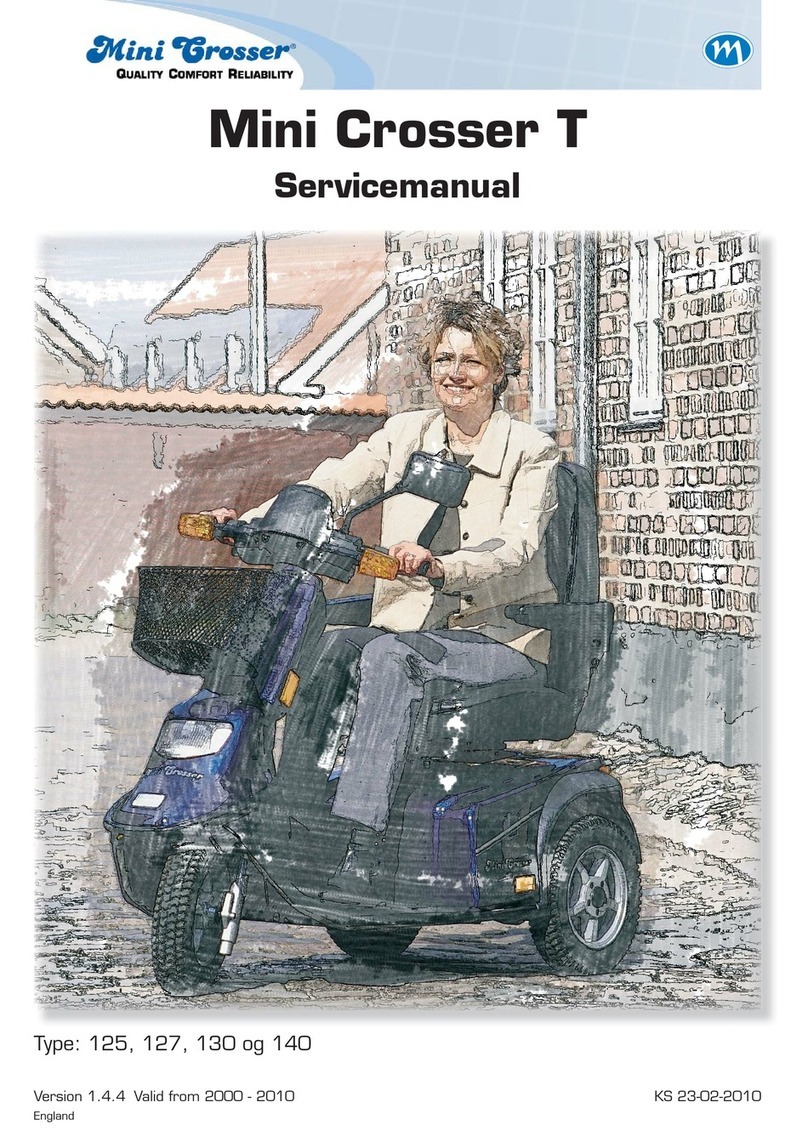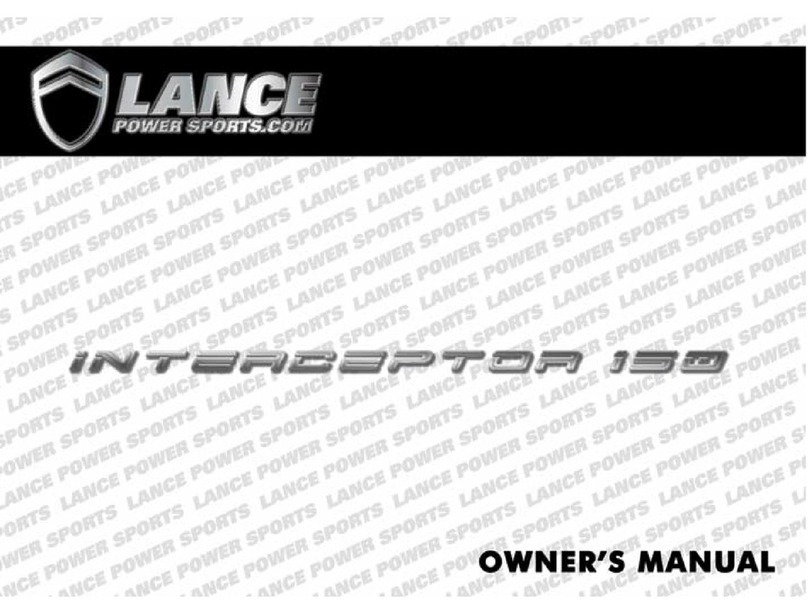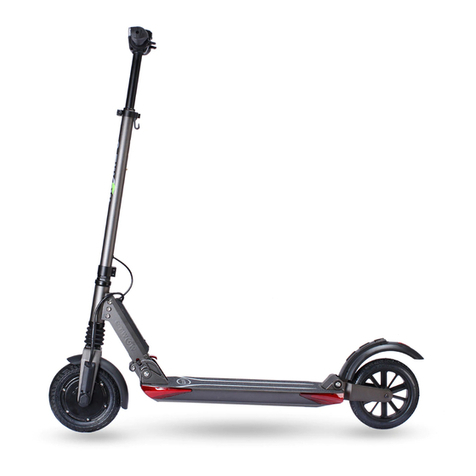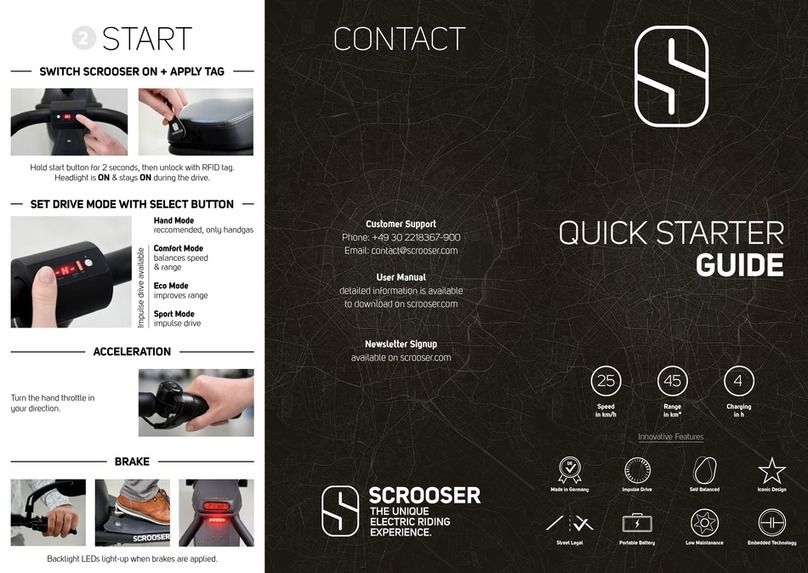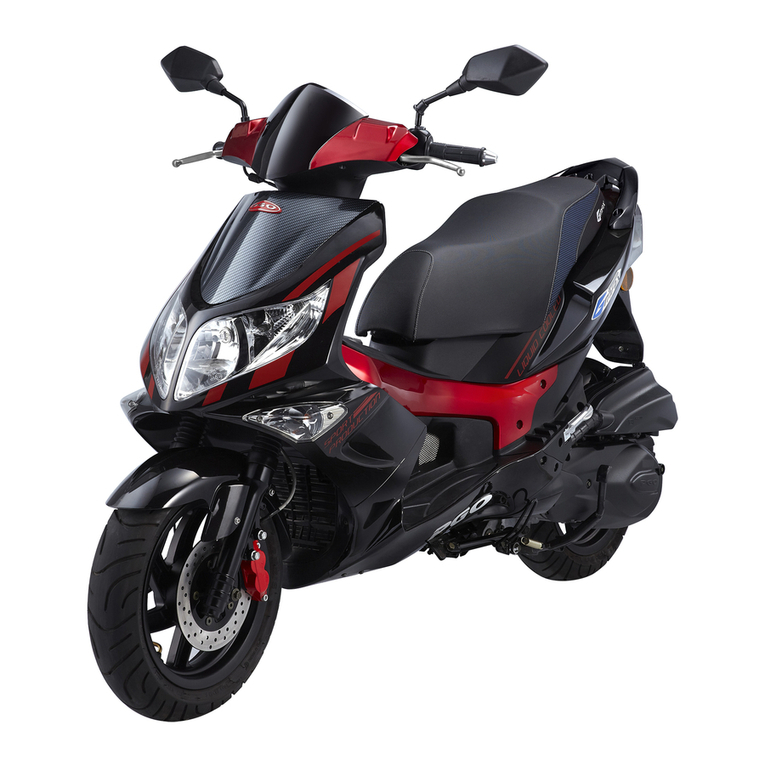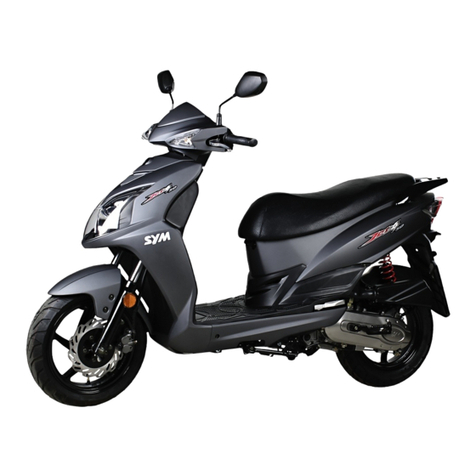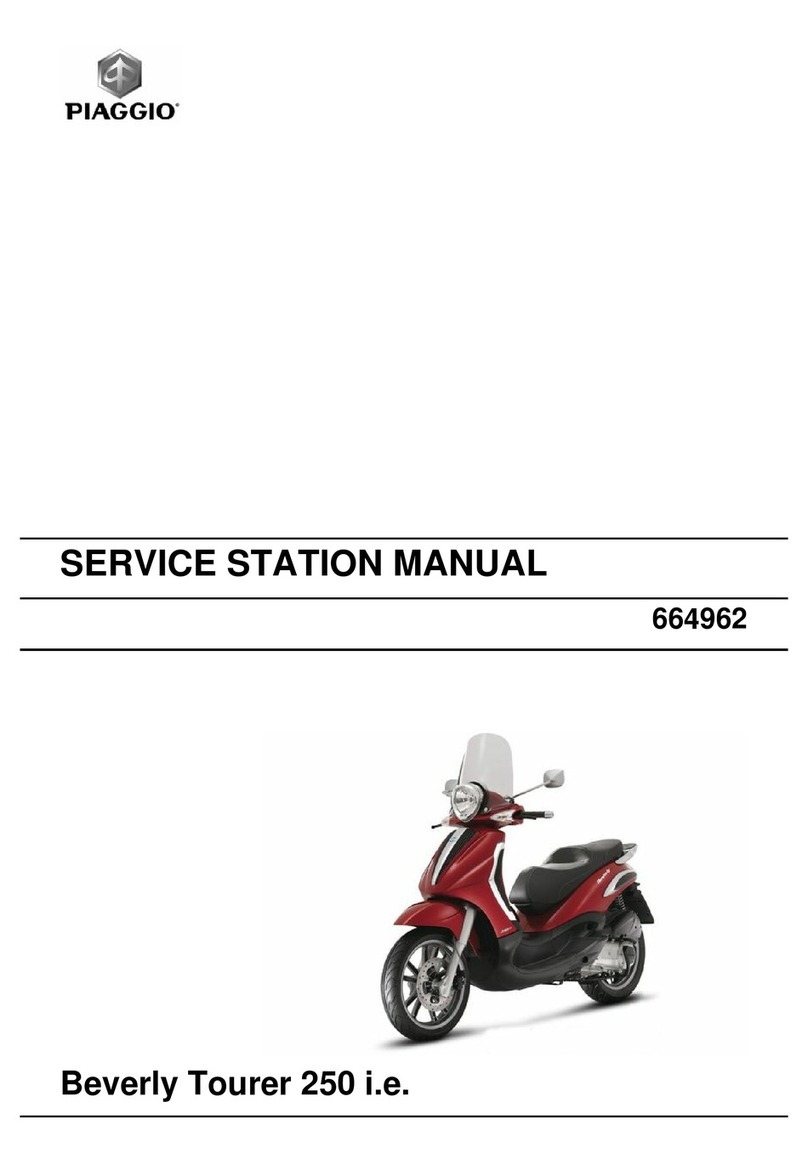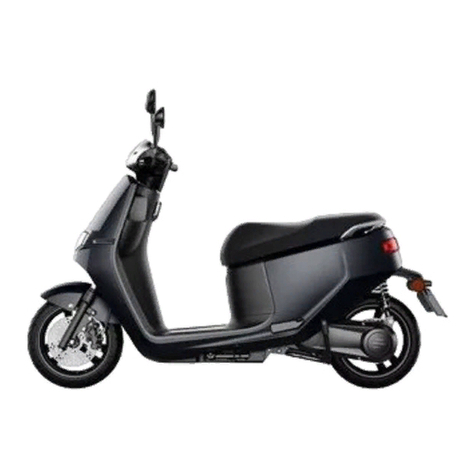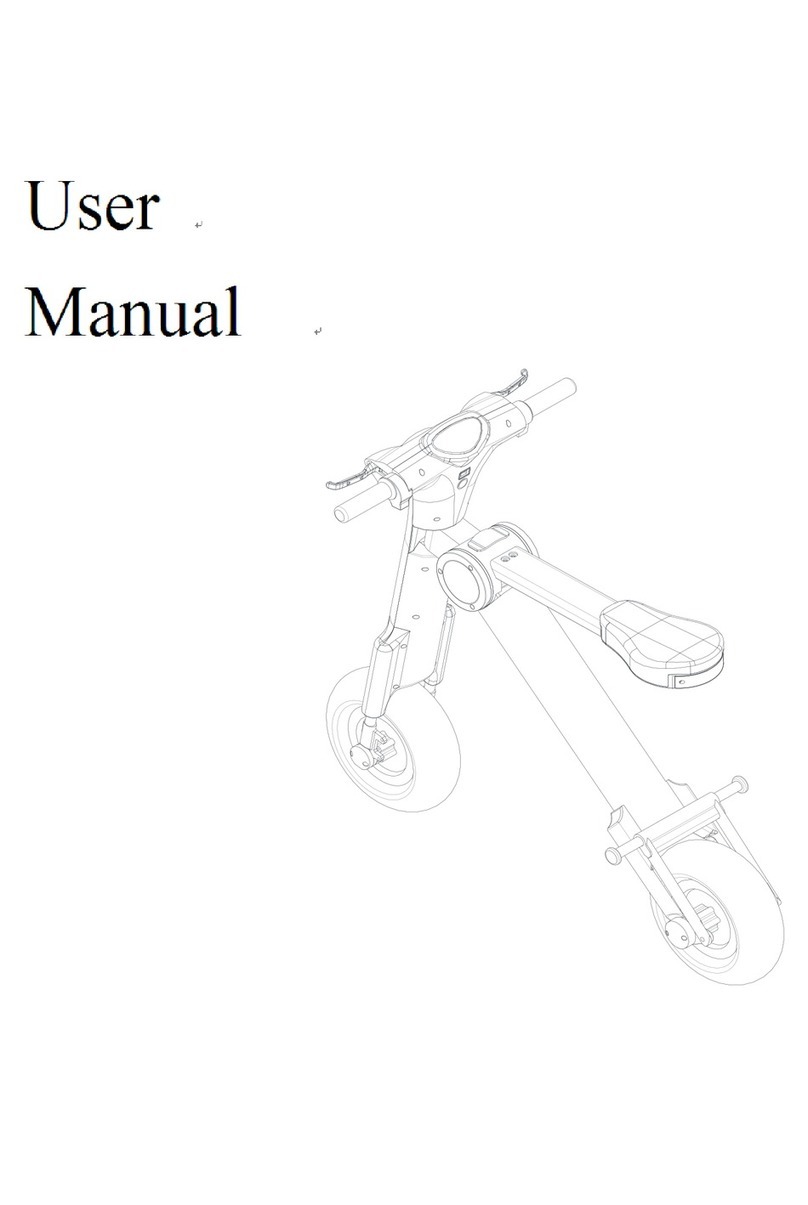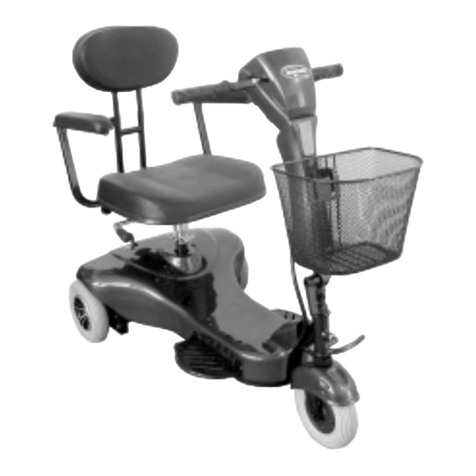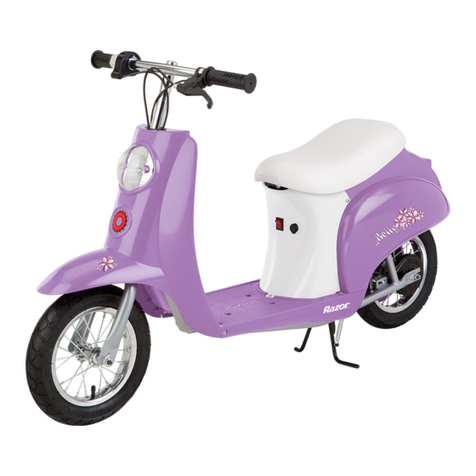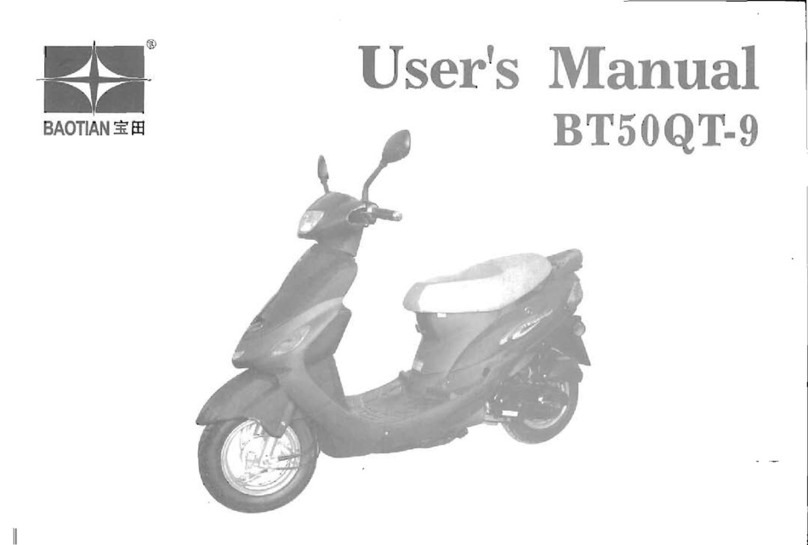LAMAX E-Scooter S7500 User manual


EN – User Manual
E-Scooter S7500

2
ENCZCZCZCZCZCZCZ
1. PACKAGE CONTENTS
–LAMAX E-Scooter S7500
–Charger
–Instruction Manual
2. PRODUCT LAYOUT
e)
l)
n)
m)
g)
k)
j)
i)
a)
d)
c)
b)
f)
p)
o)
q)
r)
h)
a) Handlebars
b) LED headlight
c) Handlebar stem
d) Latch – for folding or unfolding scooter
e) 8”front wheel
f) Latch lock
g) Deck
h) Hook (used to secure scooter when folded)
i) Hook attachment
j) Rear mudguard
k) Rear brake (auxiliary)
l) 250 W motor / 8“ rear wheel
m) Charging port
n) Kickstand
o) Multi-function LCD display
p) Throttle lever
q) Electric brake
r) Bell
CONTENTS
1. Package Contents....................................................................2
2. Product Layout .........................................................................2
3. Assembling and Folding the Scooter ...............................3
4. Multifunction Display.............................................................3
5. Operating the Scooter ...........................................................4
6. Specication..............................................................................6
7. Charging the battery..............................................................6
8. Battery – Precautions..............................................................7
9. Inspection, Maintenance, Storage.....................................7
10. Safety Precautions and Warnings....................................8

3
ENCZCZCZCZCZCZCZ
3. ASSEMBLING AND FOLDING THE SCOOTER
a) Unfolding
–Press the rear mudguard down with one hand to release the hook from the attachment. With the
other hand, hold the handlebar stem and lift it up. Close the latch onto the handlebar pole and push
the latch lock down. Make sure the handlebar stem is securely held in place.
b) Installing the handlebars
–Fit the handlebars as shown and screw in rmly. Make sure that the right (R) and left (L) handles are
correctly positioned as shown. In the event of incorrect assembly, the thread and thus the handle-
bars may be damaged.
L R
RL
c) Folding
–Lift the latch lock up and pull the latch away from the handlebar stem. Then place the handlebar
stem on the rear mudguard and insert the hook into the hook attachment on the rear mudguard.
4. MULTIFUNCTION DISPLAY
a) Button functions
–MODE button – changes speed mode (slow, medium, fast)
–POWER button – press to turn scooter on/o, double press to turn LED light on/o

4
ENCZCZCZCZCZCZCZ
b) Display information
75–100 %
50–75 %
25–50 %
0–25 %
Battery indicator Battery capacity in %
LED headlight icon Speed mode
Speed km/h
Speed mode
–A white icon indicates slow speed mode. Maximum speed in this mode is 10 km/h.
–A yellow icon indicates medium speed mode. Maximum speed in this mode is 20 km/h (recommen-
ded mode to save battery and extend maximum range).
–A red icon indicates the fast mode. Maximum speed in this mode is 25 km/h (quickly drains the
battery).
LED headlight
–Press the POWER button twice to turn on/o the LED headlight
–If the icon is displayed, the light is on
–If the icon is not displayed, the light is o
NOTE: The LED headlight should always be switched on under low visibility.
5. OPERATING THE SCOOTER
NOTE:
Whenever you ride a scooter, there is always a risk of falling o and
possible injury, so always wear a helmet as well as knee and elbow
protection.
–Limits for riders: The person riding the scooter must be at least 120 cm tall and weigh at least 30 kg.
Children may only operate or otherwise handle the scooter under the supervision of a competent
adult. The same is true for people with reduced mobility.
a) Turn on the scooter by holding down the POWER button for two seconds and hold the han-
dlebars.
b) Keep both hands on the handlebars at all times
c) As soon as the scooter is on, raise one foot onto the scooter deck and start pushing with the other
foot. After reaching a speed of 5 km/h, place the other foot onto the scooter deck for greater stability
and press the throttle lever (accelerator). You can now regulate the scooter speed by pressing or
releasing the throttle lever.
d) To stop, release the throttle lever and apply the electric brake on the handlebars. To stop faster
use the electric brake in combination with the rear auxiliary brake by placing one foot on the rear
auxiliary brake*.

5
ENCZCZCZCZCZCZCZ
e) After completing your journey, turn o the scooter by holding down the POWER button POWER
for 2 seconds.
*NOTE: The rear auxiliary brake should only be used when you need to stop as quickly as possi-
ble, or when the front brake is not working properly. Frequent use of the rear auxiliary
brake may result in tire wear and damage.
a)
d) e)
b) c)

6
ENCZCZCZCZCZCZCZ
6. SPECIFICATION
Weight: 11,9 kg
Maximum load: 120 kg
Maximum speed: 25 km/h
Maximum range: 15–22 km
Maximum climb angle: 20°
Battery: Lithium, 7.5 Ah, 36 V
Motor: 250 W
Dimensions (folded): 106.5 × 43 × 48 cm
Dimensions (unfolded): 106.5 × 43 × 118 cm
Base plate height: 13 cm
Wheels: 8‘‘ front (with tube), 8‘‘ rear (tubeless tire)
Height of person on scooter: 130–190 cm
Weight of person on scooter: 30–120 kg
Age of person on scooter: 10–60 let
Battery specifications
Type battery: Lithium
Charging time: 4 hours
(V): 36 V
Battery capacity: 7500 mAh
Operating temperature: 5 °C–50 °C
Charging temperature: 0 °C–40 °C
Storage temperature: 5 °C–25 °C
Storage humidity: 5%–85%, do not condense Aairs
7. CHARGING THE BATTERY
–To charge the battery, use only the original charger supplied with the scooter.
–If the battery indicator shows low battery capacity, connect the scooter to the charger.
–Always ensure that the charging port is clean and dry before charging. If the charger is not connec-
ted to the scooter, the power inlet must always be covered with a rubber cap to prevent dust or
other substances from entering the inlet.
–Connect the power cord to the charger and then plug the charger into a wall outlet, making sure
that the light on the charger is GREEN.
–Insert the charger plug into the power input on the scooter. Thelight chargershould turn RED –
charging. When the lamp lights up GREEN, the scooter fully charged. The time to fully charge is
approximately 3–4 hours.
–After charging the scooter, disconnect the charger from the electrical outlet and the power cord
from the scooter.
–Do not leave the scooter connected to the charger overnight. Never leave the scooter connected
to the charger unattended.

7
ENCZCZCZCZCZCZCZ
8. BATTERY PRECAUTIONS
–Fully charge the battery before rst use.
–Use only the charger designed for this type of battery
–Use standard charging cables, otherwise the device may be damaged.
–Operating temperature may aect the overall battery life.
–Never connect mechanically damaged or bloated batteries to the charger. Do not use the batteries
in this state at all, there is a risk of explosion.
–Do not use any damaged AC adapter or charger.
–Charge at room temperature, never charge below 0°C or above 40°C.
–Do not drop, puncture or damage the battery. Do not repair a damaged battery.
–Do not expose the charger or battery to moisture, water, rain, snow, or spray.
–Do not leave the battery in a vehicle, expose it to sunlight, or place it near heat sources. Strong light
or high temperatures can damage the battery.
–Never leave batteries unattended while charging, short-circuiting or accidentally overcharging
(battery unsuitable for quick charging or being charged by excessive current or in the event of char-
ger failure) can cause leakage of aggressive chemicals, explosion or re!
–Disconnect the battery immediately if the battery overheats whilst charging.
–Do not place the charger and the rechargeable battery on or near ammable objects while char-
ging. Beware of curtains, carpets, tablecloths, etc.
–For safety reasons, unplug the device when it is fully charged.
–Keep the battery away from children and animals.
–Never disassemble the charger or battery.
–If the battery is integrated, never disassemble the device unless otherwise specied. Any such
attempt is risky and may result in damage to the product and consequently void the warranty.
–Do not dispose of worn or damaged batteries in the trash, re or heating equipment, but hand them
over to a hazardous waste collection point.
–Failure to observe this policy will assume full responsibility for the damage incurred.
9. INSPECTION, MAINTENANCE, STORAGE
–The scooter needs to be inspected and undergo maintenance just like a bike or motorcycle. Always
make sure that the scooter is turned o and the power cord is disconnected before performing the
following tasks.
Checking and cleaning the scooter
–Disconnect the charger and turn o the scooter.
–Check the body and tyres regularly for damage or excessive wear. If there is excessive wear on the
tyre, it must be replaced. Do not use water or other liquids or cleaning agents for cleaning. Dampen
a clean cloth with clean soapy water and apply it to the scooter body, then rinse the cloth thorough-
ly and wipe down the scooter. Do not allow water to enter the battery cover, charging port, display
or tyres.
Maintenance and service
–The scooter requires regular maintenance and regular service just like a bicycle. We recommend
servicing the scooter at least once a year.
Storing the scooter
–Fully charge the battery before storing it. When storing the scooter for an extended period, fully
charge the battery at least once every 30 days. If this is not done, it is very likely that the equipment
will fail, which is not covered under warranty.
–If the storage temperature is below 0°C, do not charge the scooter immediately. Before charging,
the scooter must be placed in a warmer environment (5°C - 40°C) for at least 2 hours. To prevent

8
ENCZCZCZCZCZCZCZ
dust from entering the scooter, pack it up in the original box and close with tape. Store the scooter
indoors, in a dry place and at the correct storage temperature.
10. SAFETY PRECAUTIONS AND WARNINGS
–Failure to comply with the basic instructions and any of the following precautions could result in
damage to the scooter, loss of manufacturer‘s warranty, other property damage, serious injury, and
even death. Always use original accessories, including the battery. Using incompatible accessories
may void your warranty and cause damage to the equipment.
–Respect your surroundings and comply with the applicable laws and regulations of the state
in which you are located. The user must observe the applicable local trac regulations when
riding the electric scooter. In the case of unauthorized use on public roads, including cycle
paths, the user runs the risk of a ne or even criminal prosecution in the event of an accident.
–Read the manual carefully.
–Check the technical condition of the scooter before each use.
–Always check the brakes and the condition and ination level of the tyres before riding. Check that
there are no objects obstructing the wheel.
–When riding a scooter, wear all appropriate safety and protective gear (especially a helmet).
–Never ride without holding the handlebars.
–Wear sturdy, closed shoes when riding a scooter.
–Look where you are going and look at the road conditions, people, places, property and objects
around you.
–Operate the scooter with regard to pedestrians, cars and cyclists.
–Pay full attention to riding when on your journey. Do not use the scooter while talking, making
phone calls, sending SMS messages, or otherwise handling your phone or other device that may
distract you.
–Do not ride on a scooter unless permitted to do so.
–Always follow local regulations.
–Do not drive on motorways or 1st and 2nd class roads.
–Do not drive in areas with a large number of pedestrians.
–Do not remove scooter reectors or LED lights.
–Never drive in the rain.
–Do not hang bags, backpacks or other objects on the scooter.
–As a general rule, do not attempt to disassemble, repair or modify the device. Disassembling, mo-
difying, or attempting to repair the product will void the warranty and may result in damage to the
unit or even injury or property damage.
–Do not use the device under the inuence of alcohol, drugs or other addictive substances and sub-
stances aecting coordination ability and response time.
–Do not use the scooter if you are tired or sleepy.
–Use your best judgment to avoid dangerous situations with your scooter.
–Do not ride your scooter on ramps or in a skate park, empty swimming pool or skateboarding area.
Do not ride railings, scooter jumps or attempt to overcome obstacles.
–Do not turn sharply, especially at high speeds.
–Do not drive into or near puddles of water, mud, sand, stones, gravel, or in rough and rugged terrain.
This may damage the scooter. If you encounter an uneven sidewalk, lift the scooter and go past the
obstacle.
–Do not drive in bad weather: snow, rain, hail, on icy roads or in extreme heat. On damp or wet roads,
skidding, it is much easier to fall or lose your balance.
–Do not drive near pools or other large bodies of water.
–Bend your knees when riding on bumpy or uneven surfaces to absorb shocks and vibrations and

9
ENCZCZCZCZCZCZCZ
help you maintain stability. If you are unsure whether you can safely ride on a particular terrain, get
o the scooter and push it.
–Do not ride over bumps or objects higher than 1.5 cm.
–Any changes made to the software voids the warranty.
–Handle the scooter with care when indoors.
–On a scooter, do not ride on an incline steeper than 15° (always kick on a steep climb).
–The scooter is designed to be used by one person, NEVER ride with two people on board.
–Women who are pregnant should not operate the scooter
–Children should only operate or otherwise handle the scooter under the supervision of a competent
adult. The same is true for people with reduced mobility.
–Always consider longer braking distances at higher speeds.
–Do not jump the scooter while riding.
–Do not jump on the scooter while riding.
–Do not attempt stunts or tricks with your scooter.
–Do not ride the scooter in dark or poorly lit areas.
–Do not use a scooter out of designated places.
–Do not exceed the maximum load capacity of the scooter.
–Avoid driving near hazardous substances: ammable gas, steam, dust and water that could cause
a scooter re.
–Under ideal conditions and with a fully charged battery, the scooter can travel 15 to 22 km.
–Factors that aect the maximum range of the scooter: terrain, weight, ambient temperature, speed
and driving style.
Learn more
1) For households: The symbol (crossed-out wheelie bin) on the product or in the accompanying
documentation means that used electrical or electronic products must not be disposed of along with
household waste. In order to dispose of the product properly, hand it over to a designated collection
point for free collection. The correct disposal of this product will help save valuable natural resources
and help prevent potential negative consequences for the environment and human health, which cou-
ld be caused by inappropriate waste handling. Contact your local authority or nearest collection point
for more details. Penalties may be applicable for incorrect disposal of this type of waste, in accordance
with national regulations. Information for users on the disposal of electrical and electronic equipment
(Corporate and Business Use): For proper disposal of electrical and electronic equipment, request de-
tailed information from your dealer or supplier. Information for users on the disposal of electrical and
electronic equipment in other countries outside the European Union: The above symbol (crossed out
bin) is only valid in the European Union. For proper disposal of electrical and electronic equipment,
please request detailed information from your local authorities or the retailer. This is expressed by the
crossed-out bin symbol on the product, packaging or printed materials.
2) Warranty repairs should be carried out at your dealer. If you have technical problems or questions,
please contact your dealer for further information. Observe the rules for working with electrical equi-
pment. The user is not authorized to disassemble the device or replace any part of it. There is a risk of
electric shock when you open or remove covers. You may also be exposed to an electric shock if the
unit is assembled incorrectly and reconnected.
The warranty period for products is 24 months, unless stated otherwise. The warranty does not co-
ver damage caused by non-standard use, mechanical damage, exposure to aggressive conditions,
handling contrary to the manual and normal wear and tear. The warranty period on the battery is 24
months, and its capacity is 6 months.
The manufacturer, importer and distributor are not responsible for any damages caused by the
assembly or misuse of the product.

10
ENCZCZCZCZCZCZCZ
Declaration of Conformity
Hereby, elem6 sro declares that all LAMAX equipment is in compliance with the essential require-
ments and other relevant provisions of Directives 2014/30/EU, 2014/35/EU and 2006/42/EC. The
products are intended for sale without restrictions in Germany, the Czech Republic, Slovakia, Po-
land, Hungary and other EU member states. The warranty period for products is 24 months, unless
stated otherwise. The warranty period on the battery is 24 months, and its capacity is 6 months. The
Declaration of Conformity can be downloaded from www.lamax-electronics.com/support/doc.
Manufacturer:
elem6 s.r.o., Braškovská 308/15, 16100 Prague 6, Czech Republic
www.lamax-electronics.com
Subject to printing errors and changes to the manual.

DE – Benutzerhandbuch
E-Scooter S7500

2
DEDECZCZCZCZCZCZ
1. VERPACKUNGSINHALT
–Roller LAMAX S7500
–Ladegerät
–Anleitung
2. PRODUKTBESCHREIBUNG
e)
l)
n)
m)
g)
k)
j)
i)
a)
d)
c)
b)
f)
p)
o)
q)
r)
h)
a) Lenkergri
b) LED-Licht
c) Lenkstange
d) Verriegelung – zum Zusammen-
und Auseinanderklappen des Rollers
e) 8“ Vorderrad
f) Sicherung
g) Trittbrett
h) Haken (zur Verankerung des Rollers
im zusammengeklappten Zustand)
i) Önung für den Haken
j) Rückstrahler
k) Hinterradbremse (Hilfsbremse)
l) 250 W Motor/8‘‘ Hinterrad
m) Ladeanschluss
n) Ständer
o) Multifunktionsdisplay
p) Gashebel
q) Elektrische Bremse
r) Klingel
INHALT
1. Verpackungsinhalt...................................................................2
2. Produktbeschreibung ............................................................2
3. Roller zusammenbauen und zusammenklappen........3
4. Multifunktionsdisplay ............................................................4
5. Roller bedienen ........................................................................4
6. Spezikation..............................................................................6
7. Batterie auaden......................................................................6
8. Batterie – Sicherheitsgrundsätze.......................................7
9. Prüfung, Wartung, Lagerung...............................................7
10. Sicherheitsgrundsätze und –hinweise...........................8

3
DEDECZCZCZCZCZCZ
3. ROLLER ZUSAMMENBAUEN UND ZUSAMMENKLAPPEN
a) Auseinanderklappen
–Den hinteren Kotügel mit einer Hand nach unten drücken und den Haken von der Önung lö-
sen. Die Lenkstange mit der anderen Hand halten und nach oben ziehen. Die Verriegelung an
der Lenkstange befestigen und die Sicherung nach unten drücken. Stellen Sie sicher, dass die
Lenkstange fest sitzt.
b) Lenker montieren
–Den Lenker wie in der Abbildung aufsetzen und fest verschrauben. Stellen Sie sicher, dass der rechte
(R) und der linke (L) Lenkergri wie in der Abbildung richtig platziert sind. Bei falscher Montage
kann das Gewinde und dadurch auch der Lenker beschädigt werden
L R
RL
c) Zusammenklappen
–Die Sicherung nach oben heben und die Verriegelung von der Lenkstange hin lösen. Dann die
Lenkstange an den hinteren Kotügel legen und den Haken in die Önung am hinteren Kotügel
stecken.

4
DEDECZCZCZCZCZCZ
4. MULTIFUNKTIONSDISPLAY
a) Tastenfunktionen
–MODE-Taste – zum Wechseln der Geschwindigkeitsstufen (langsam, mittel, schnell)
–POWER-Taste – beim Drücken und Halten wird der Roller ein-/ausgeschaltet, beim dop-
pelten Drücken wird das LED-Licht ein-/ausgeschaltet
b) Angaben auf dem Display
75–100 %
50–75 %
25–50 %
0–25 %
Batterieanzeige Batteriekapazität in %
LED-Licht-Ikone Geschwindigkeitsstufe
Geschwindigkeit km/h
Ikone der Geschwindigkeitsstufe
–Weiße Ikone zeigt die langsame Geschwindigkeitsstufe an. Die Höchstgeschwindigkeit in dieser
Stufe beträgt 10 km/h
–Gelbe Ikone zeigt die mittlere Geschwindigkeitsstufe an. Die Höchstgeschwindigkeit in dieser Stufe
beträgt 20 km/h (empfohlene Stufe, spart Batterie und verlängert die maximale Reichweite)
–Rote Ikone zeigt die schnellste Geschwindigkeitsstufe an. Die Höchstgeschwindigkeit in dieser Stufe
beträgt 25 km/h (schnellstes Entladen der Batterie)
LED-Licht-Ikone
–Durch das doppelte Drücken der POWER-Taste schalten Sie das LED-Licht ein/aus.
–Wenn die Ikone auf dem Display angezeigt wird, ist das Licht eingeschaltet.
–Wenn die Ikone auf dem Display nicht angezeigt wird, ist das Licht ausgeschaltet.
ANMERKUNG: Die LED-Beleuchtung muss bei eingeschränkter Sicht immer eingeschaltet sein.
5. ROLLER BEDIENEN
ACHTUNG:
Bei jeder Fahrt mit dem Roller besteht die Sturz- und Verletzungsge-
fahr; tragen Sie deshalb immer einen Schutzhelm sowie Knie- und
Ellbogenschutz.

5
DEDECZCZCZCZCZCZ
–Einschränkungen für Rollerfahrer: Ein Rollerfahrer muss mindestens 120 cm groß und mindestens
30 kg schwer sein. Kinder dürfen den Roller nur unter Aufsicht eines Erwachsenen bedienen oder
auf eine andere Weise benutzen. Gleiches gilt auch für Personen mit eingeschränkter Bewegu-
ngsfähigkeit.
a) Schalten Sie den Roller durch das Drücken und Halten der POWER -Taste für zwei Sekunden,
und greifen Sie den Lenker.
b) Halten Sie beide Hände am Lenker während der Fahrt.
c) Sobald der Roller eingeschaltet ist, treten Sie mit einem Fuß auf das Trittbrett und mit dem anderen
Fuß treten Sie ab. Nachdem die Geschwindigkeit 5 km/h erreicht wurde, treten Sie auch mit dem
anderen Fuß auf das Trittbrett für eine höhere Stabilität und drücken Sie den Gashebel (Beschleu-
nigung). Regulieren Sie nun die Geschwindigkeit des Rollers durch das Drücken oder Loslassen des
Gashebels.
d) Wenn Sie anhalten wollen, lassen Sie den Gashebel los und benutzen Sie die manuelle elektrische
Bremse am Lenker. Benutzen Sie für ein schnelleres Anhalten die manuelle elektrische Bremse in
Kombination mit der Hinterradbremse durch das Treten auf diese mit einem Fuß*.
e) Schalten Sie den Roller nach dem Ende der Fahrt aus, indem Sie die POWER-Taste 2 Sekunden
lang gedrückt halten.
*HINWEIS: Die Hinterradbremse (Hilfsbremse) ist nur für den Einsatz in Notfällen vorgesehen,
bei denen man so schnell wie möglich anhalten muss, oder wenn die Vorderbremse
nicht richtig funktioniert. Bei häuger Benutzung der Hinterradbremse kann diese
abgenutzt und der Reifen zerstört werden.
a)
d) e)
b) c)

6
DEDECZCZCZCZCZCZ
6. SPEZIFIKATION
Gewicht: 11,9 kg
Maximale Tragkraft: 120 kg
Maximale Geschwindigkeit: 25 km/h
Maximale Reichweite: 15–22 km
Maximale Steigung: 20°
Batterie: Lithium, 7.5 Ah, 36 V
Motor: 250 W
Abmessungen (zusammengeklappt): 106.5 × 43 × 48 cm
Abmessungen (auseinandergeklappt): 106.5 × 43 × 118 cm
Trittbretthöhe: 13 cm
Räder: 8“ Vorderrad (mit Schlauch),
8“ Hinterrad (schlauchloser Reifen)
Größe des Rollerfahrers: 130–190 cm
Gewicht des Rollerfahrers: 30–120 kg
Alter des Rollerfahrers: 10–60 let
Spezifikation der Batterie
Batterietyp: Lithiumbatterie
Ladedauer: 4 Stunden
(V): 36 V
Batteriekapazität: 7500 mAh
Ladedauer: 5 °C–50 °C
Ladetemperatur: 0 °C–40 °C
Lagertemperatur: 5 °C–25 °C
Lagerfeuchtigkeit: 5 %–85 %, nicht kondensierend
7. BATTERIE AUFLADEN
–Verwenden Sie zum Auaden der Batterie nur das mit dem Roller mitgelieferte originelle Ladegerät.
–Wenn die Batterieanzeige eine niedrige Batteriekapazität anzeigt, schließen Sie den Roller an das
Ladegerät an.
–Stellen Sie vor dem Laden sicher, dass der Ladeanschluss sauber und trocken ist. Wenn das La-
degerät an dem Roller gerade nicht angeschlossen ist, muss der Ladeanschluss immer mit der
Gummikappe geschützt sein, damit kein Staub oder andere Stoe in den Ladeanschluss eindringen
können.
–Stecken Sie das Ladekabel in das Ladegerät und dann schließen Sie das Ladegerät an die Steckdose
an. Stellen Sie sicher, dass das Licht am Ladegerät GRÜN leuchtet.
–Stecken Sie den Stecker des Ladegeräts in den Ladeanschluss des Rollers. Die Kontrollleuchte des
Ladegeräts sollte ROT aueuchten – Ladevorgang. Wenn die Kontrollleuchte GRÜN aueuchtet, ist
der Roller vollständig aufgeladen. Die Ladedauer für vollständiges Auaden beträgt etwa 3-4 Stun-
den.
–Trennen Sie das Ladegerät nach dem Auaden des Rollers von der Steckdose und das Ladekabel
von dem Roller.
–Lassen Sie den Roller mit dem angeschlossenen Ladegerät nicht über Nacht laden. Lassen Sie den
am Ladegerät angeschlossenen Roller niemals unbeaufsichtigt.

7
DEDECZCZCZCZCZCZ
8. BATTERIE SICHERHEITSGRUNDSÄTZE
–Vor der ersten Benutzung laden Sie die Batterie vollständig auf.
–Verwenden Sie für das Laden nur ein Ladegerät, das für diesen Batterietyp bestimmt ist.
–Verwenden Sie für das Laden nur Standardkabel, ansonsten besteht Gefahr von Schäden an dem
Gerät.
–Die Temperatur beim Betrieb kann sich auf die Batteriedauer auswirken.
–Schließen Sie in keinem Fall mechanisch beschädigte oder aufgeblähte Batterien an das Lade-
gerät an. Benutzen Sie die Batterie in solchem Zustand nicht mehr, es besteht Explosionsgefahr.
–Verwenden Sie kein beschädigtes Netzteil oder Ladegerät.
–Führen Sie das Laden bei der Raumtemperatur durch, laden Sie niemals bei einer Temperatur
unter 0°C oder über 40°C.
–Sturz der Batterie vermeiden, Batterie nicht durchstechen oder auf eine andere Weise beschädi-
gen. Beschädigte Batterie nicht reparieren.
–Ladegerät und Batterie vor Feuchtigkeit, Wasser, Regen, Schnee oder Bespritzung schützen.
–Batterie nicht im Fahrzeug lassen, der Sonnenstrahlung nicht aussetzen und nicht in der Nähe
von Wärmequellen aufbewahren. Starkes Licht oder hohe Temperaturen können die Batterie be-
schädigen.
–Den Akku während des Ladevorgangs nicht unbeaufsichtigt lassen, Kurzschluss oder unbeab-
sichtigte Überladung (eines nicht für das Schnellladen vorgesehenen Akkus oder eines mit Über-
strom geladenen Akkus oder bei einer Störung des Ladegeräts) kann Freisetzung von aggressiven
Chemikalien, Explosion oder Brand verursachen!
–Sollte sich die Batterie beim Auaden übermäßig erwärmen, trennen Sie die Batterie sofort ab.
–Das Ladegerät oder den aufzuladenden Akku beim Laden nicht auf brennbare Gegenstände oder
in ihrer Umgebung legen. Vorsicht bei Gardinen, Teppichen, Tischdecken usw.
–Sobald das Gerät vollständig aufgeladen ist, trennen Sie es aus Sicherheitsgründen ab.
–Die Batterie außer Reich- und Sichtweite von Kindern und Tieren aufbewahren.
–Das Ladegerät und die Batterie niemals zerlegen.
–Wenn die Batterie integriert ist, das Gerät niemals zerlegen, soweit nicht etwas anderes festgelegt
ist. Jeder solche Versuch ist gefährlich und kann Schäden am Produkt und das Erlöschen der Ga-
rantie zur Folge haben.
–Alte oder beschädigte Batterien nicht in den Mülleimer, Feuer oder Feuerungen werfen, sondern
bei einer Sammelstelle für Sondermüll entsorgen.
–Falls diese Grundsätze nicht beachtet werden, tragen Sie volle Verantwortung für entstandenen
Schaden.
9. PRÜFUNG, WARTUNG, LAGERUNG
–Der Roller benötigt regelmäßige Prüfung und Wartung wie zum Beispiel ein Fahrrad oder Motorrad.
Vor der Durchführung folgender Handlungen stellen Sie immer sicher, dass der Roller ausgeschaltet
und das Ladekabel abgetrennt ist.
Prüfung und Reinigung des Rollers
–Trennen Sie das Ladegerät ab und schalten Sie den Roller aus.
–Überprüfen Sie regelmäßig die Konstruktion und die Reifen auf Schäden und übermäßige Abnut-
zung. Bei übermäßiger Abnutzung sind die Reifen zu wechseln. Zur Reinigung kein Wasser oder
andere Flüssigkeiten und Reinigungsmittel verwenden. Feuchten Sie einen sauberen Tuch mit sau-
berem Seifenwasser an und tragen Sie dieses auf die Konstruktion des Rollers auf, dann den Tuch
gründlich spülen und den Roller abwischen. Achten Sie bei der Reinigung darauf, dass kein Wasser
in das Batteriegehäuse, den Ladeanschluss, das Display oder die Reifen eindringt.

8
DEDECZCZCZCZCZCZ
Wartung und Service
–Der Roller benötigt regelmäßige Wartung und regelmäßigen Service ähnlich wie ein Fahrrad. Emp-
fohlene Serviceintervalle – mindestens 1x jährlich.
Aufbewahrung des Rollers
–Vor der Lagerung laden Sie die Batterie vollständig auf.Wenn der Roller für einen längeren Zeitraum
gelagert wird, laden Sie die Batterie mindestens 1x in 30 Tagen auf. Sollten Sie das nicht tun, ist sehr
wahrscheinlich, dass eine Störung am Gerät auftritt, die nicht als ein Grund für die Garantiereparatur
berücksichtigt werden kann.
–Wenn die Lagertemperatur in den Räumen unter 0 °C liegt, laden Sie den Roller nicht sofort auf.
Vor dem Laden muss der Roller in eine wärmere Umgebung (5°C – 40 °C) für mindestens 2 Stunden
gebracht werden. Wenn Sie das Eindringen von Staub in den Roller vermeiden wollen, verpacken
Sie ihn in den Originalkarton und verschließen mit einem Klebeband. Lagern Sie den Roller in Innen-
bereichen, trocken und bei richtiger Lagertemperatur.
10. SICHERHEITSGRUNDSÄTZE UND HINWEISE
–Nichtbeachtung der grundlegenden Hinweise und einiger der folgenden Sicherheitsmaßnahmen
kann zu Schäden am Roller, Erlöschen der Garantie, anderen Sachschäden, schweren Verletzungen
oder sogar zum Tod führen. Verwenden Sie immer nur Originalzubehörteile einschließlich Batterie.
Bei Verwendung von nicht kompatiblen Zubehörteilen kann die Garantie erlöschen und das Gerät
beschädigt werden.
–Achten Sie auf Ihre Umgebung und halten Sie gültige Vorschriften und Gesetze des Landes,
in dem Sie sich benden, ein. Der Benutzer muss bei seiner Fahrt mit dem Roller gültige lo-
kale Verkehrsvorschriften einhalten. Bei unerlaubter Nutzung auf öentlichen Straßen ein-
schließlich Radwege kann der Benutzer mit einer Geldstrafe bestraft oder beim verschulde-
ten Verkehrsunfall sogar strafrechtlich verfolgt werden.
–Lesen Sie die Anleitung sorgfältig durch.
–Prüfen Sie vor jedem Gebrauch den technischen Zustand des Rollers.
–Vor der Fahr überprüfen Sie immer die Bremsen, den Druck und den Zustand der Reifen. Überprüfen
Sie, dass keine Gegenstände im Radbereich vorhanden sind, welche die Fahrt beeinträchtigen
können.
–Tragen Sie bei der Fahrt mit dem Roller geeignete Sicherheitsausrüstung (insbesondere einen
Helm).
–Niemals fahren, ohne den Lenker zu halten.
–Bei der Fahrt mit dem Roller feste, geschlossene Schuhe tragen.
–Sehen Sie genau, wo Sie hinfahren, nehmen Sie dieVerhältnisse auf der Fahrbahn, Personen,Vermö-
gen und Gegenstände um Sie herum wahr.
–Fahren Sie mit den Roller unter Berücksichtigung der Fußgänger, Autos und Radfahrer.
–Widmen Sie sich voll und ganz dem Fahren. Verwenden Sie den Roller nicht, wenn Sie sprechen, te-
lefonieren, SMS-Nachrichten senden oder dasTelefon oder ein anderes Gerät, das Ihre Aufmerksam-
keit ablenken kann, benutzen.
–Benutzen Sie den Roller nicht an Stellen, wo es nicht erlaubt ist.
–Beachten Sie immer lokale Verordnungen und Vorschriften.
–Fahren Sie nicht auf Straßen der 1. und 2. Klasse für Kraftfahrzeuge und auf den Autobahnen.
–Vermeiden Sie Orte mit hoher Fußgängerfrequenz.
–Entfernen Sie keine Signalelemente am Roller wie reektierende Aufkleber oder LED-Beleuchtung.
–Fahren Sie niemals beim Regen.
–Hängen Sie den Roller nicht an Taschen, Rucksäcken oder anderen Gegenständen.
–Versuchen Sie keinesfalls das Gerät zu zerlegen, zu reparieren oder anzupassen. Bei Demontage,
Table of contents
Languages:
Other LAMAX Scooter manuals

